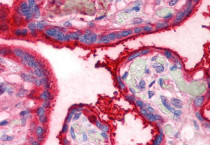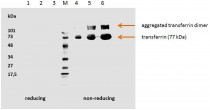ARG65462
anti-Transferrin antibody [HTF-14] (low endotoxin)
anti-Transferrin antibody [HTF-14] (low endotoxin) for ELISA,Functional study,ICC/IF,IHC-Formalin-fixed paraffin-embedded sections,Radioimmunoassay,Western blot and Human,Pig,Rabbit
概述
| 产品描述 | Azide free and low endotoxin Mouse Monoclonal antibody [HTF-14] recognizes Transferrin |
|---|---|
| 反应物种 | Hu, Pig, Rb |
| 不反应物种 | Cow, Dog, Hrs, Sheep |
| 应用 | ELISA, FuncSt, ICC/IF, IHC-P, RIA, WB |
| 特异性 | The antibody HTF-14 recognizes an epitope located in the N-terminal domain of human serum transferrin, a 77 kDa single polypeptide chain glycoprotein (member of the iron binding family of proteins). It is synthesised in the liver and consists of two domains each having a high affinity reversible binding site for Fe3+. |
| 宿主 | Mouse |
| 克隆 | Monoclonal |
| 克隆号 | HTF-14 |
| 同位型 | IgG1 |
| 靶点名称 | Transferrin |
| 抗原物种 | Pig |
| 抗原 | Purified porcine transferrin. |
| 偶联标记 | Un-conjugated |
| 別名 | Beta-1 metal-binding globulin; Siderophilin; Transferrin; PRO1557; TFQTL1; Serotransferrin; PRO2086 |
应用说明
| 应用建议 |
|
||||||||||||||
|---|---|---|---|---|---|---|---|---|---|---|---|---|---|---|---|
| 应用说明 | * The dilutions indicate recommended starting dilutions and the optimal dilutions or concentrations should be determined by the scientist. |
属性
| 形式 | Liquid |
|---|---|
| 纯化 | Purified by precipitation and chromatography. |
| 纯化说明 | 0.2 µm filter sterilized. Endotoxin level is <0.01 EU/µg of the protein. |
| 缓冲液 | PBS |
| 浓度 | 1 mg/ml |
| 存放说明 | For continuous use, store undiluted antibody at 2-8°C for up to a week. For long-term storage, aliquot and store at -20°C or below. Storage in frost free freezers is not recommended. Avoid repeated freeze/thaw cycles. Suggest spin the vial prior to opening. The antibody solution should be gently mixed before use. |
| 注意事项 | For laboratory research only, not for drug, diagnostic or other use. |
生物信息
| 数据库连接 | |
|---|---|
| 基因名称 | TF |
| 全名 | transferrin |
| 背景介绍 | This gene encodes a glycoprotein with an approximate molecular weight of 76.5 kDa. It is thought to have been created as a result of an ancient gene duplication event that led to generation of homologous C and N-terminal domains each of which binds one ion of ferric iron. The function of this protein is to transport iron from the intestine, reticuloendothelial system, and liver parenchymal cells to all proliferating cells in the body. This protein may also have a physiologic role as granulocyte/pollen-binding protein (GPBP) involved in the removal of certain organic matter and allergens from serum. [provided by RefSeq, Sep 2009] |
| 生物功能 | Transferrins are iron binding transport proteins which can bind two Fe(3+) ions in association with the binding of an anion, usually bicarbonate. It is responsible for the transport of iron from sites of absorption and heme degradation to those of storage and utilization. Serum transferrin may also have a further role in stimulating cell proliferation. [UniProt] |
| 细胞定位 | Secreted. [UniProt] |
| 预测分子量 | 77 kDa |
检测图片 (2) Click the Picture to Zoom In
-
ARG65462 anti-Transferrin antibody [HTF-14] (low endotoxin) IHC-P image
Immunohistochemistry: Paraffin-embedded Human placenta tissue stained with ARG65462 anti-Transferrin antibody [HTF-14] (low endotoxin).
-
ARG65462 anti-Transferrin antibody [HTF-14] (low endotoxin) WB image
Western blot: Human Transferrin with different lodings. 1) 5 µg, 2) 3 µg, 3) 1 µg, M) marker, 4) 1 µg, 5) 3 µg, and 6) 5 µg stained with ARG65462 anti-Transferrin antibody [HTF-14] (low endotoxin).
Lane 1-3: Reducing condition. Lane 4-6: Non-reduring condition.
克隆号文献









